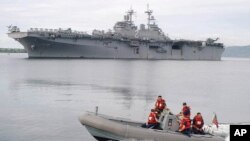Two decades after American forces were evicted from their biggest base in the Pacific, the Philippines may ask the United States back to counter China's growing military power. The United States and the Philippines are in talks to increase the American military presence in Southeast Asia.
According to a report in The Washington Post newspaper, the Philippines has indicated a willingness to host American ships, surveillance aircraft and joint military exercises.
The U.S. was forced to leave its naval base in the Philippines Subic Bay in the 1990s after lawmakers rejected a new treaty. But Carl Thayer, Southeast Asia analyst with the University of New South Wales says the Philippines' leadership is now reaching out to the U.S. to counter China's growing military power and continued confrontational incidents between Chinese and Philippine vessels in the South China Sea.
“The Philippines' nationalism is aroused because there are even further intrusions since last year in the Philippines waters and the Philippines has got basically a very low basis of which to even know what's going on let alone exercise jurisdiction,” Thayer said.
The South China Sea is of tremendous strategic importance to world shipping and is believed to hold huge oil and gas reserves. China, the Philippines, Vietnam, Taiwan, Brunei and Malaysia all hold competing claims to parts of the sea.
The talk of an increased American military presence in the Philippines follows agreements to base thousands of U.S. troops in Australia and to station warships in Singapore.
Thayer is not surprised by the talk of again increasing American and Philippine ties, given that in the last few years the Philippines has been the most vocal advocate for U.S. involvement in the region, and is the largest recipient of U.S. military assistance in Southeast Asia. The United States already has about 600 Special Operations forces advising the Philippine military engaged in fighting al-Qaida linked rebels.
The U.S. takes no position on individual claims in the South China Sea, but supports a multilateral approach to settle disputes based on international maritime law and the U.N. Convention on the Law of the Seas.
Thayer says concern about China has given the U.S. military the opening to redeploy to the Asia Pacific region to protect its own economic and strategic interests and to be welcomed as a force for stability.
“This re-balancing and the talk about Asia Pacific extends all the way down to rotating Marines through Australia, is to extend the instant reach for the United States to react to contingencies and to exhibit a constant pressure of reassurance and stability throughout the region," Thayer said.
He says Southeast Asian support for increased U.S. involvement has forced China to reassess its strategy in the South China Sea, and to focus more on engaging counties in the region through diplomatic channels.








